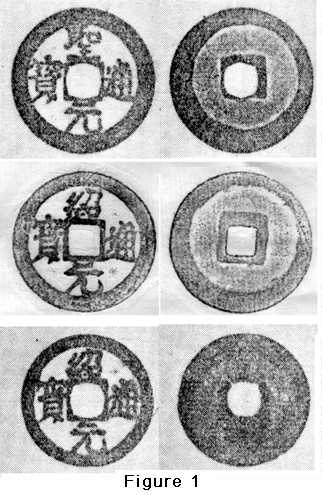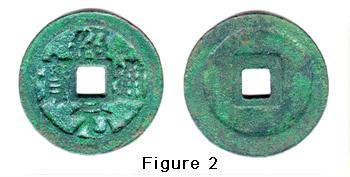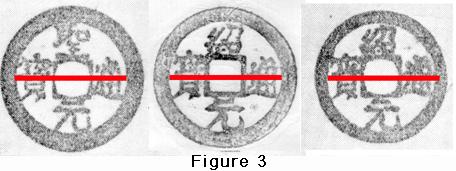 Both
Miura Gosen's first volume on official Vietnamese coins and Ding Fu Pao's
work attribute the coin at the top of figure 1, Thanh Nguyen Thong Bao,
to Ho Quy Ly during this time. The coin is well manufactured and is large
with a diameter of 25mm. This coin is well known for its distinct calligraphic
style and has a characteristic reverse. Many small, diminutive coins of
this reign title exist but none bare any resemblance to the coin in figure
1. These smaller coins are unlikely to be official issues and may not be
from this period of Vietnamese history. Both
Miura Gosen's first volume on official Vietnamese coins and Ding Fu Pao's
work attribute the coin at the top of figure 1, Thanh Nguyen Thong Bao,
to Ho Quy Ly during this time. The coin is well manufactured and is large
with a diameter of 25mm. This coin is well known for its distinct calligraphic
style and has a characteristic reverse. Many small, diminutive coins of
this reign title exist but none bare any resemblance to the coin in figure
1. These smaller coins are unlikely to be official issues and may not be
from this period of Vietnamese history.
Miura Gosen's second volume on Vietnamese coins arranged by calligraphic
style includes another coin with very similar calligraphic style, Thieu
Nguyen Thong Bao, which is shown at the bottom of figure 1. The strong
similarities between the calligraphic styles of the two coins has led some
to assign this coin to Ho Quy Ly's son during his reign between 1403 and
1407. Others have dismissed this assignment, probably due to a lack of
more evidence.
More interesting is the fact that the inner diameter (of the outside
rim) of the top two coins is exactly the same, the inner diameter being
one feature that can not change as a coin wears. This inner diameter of
the top two coins is notably larger than that of the bottom piece (see
the comparison in figure 3). Other similarities between the two top coins
include the distinctive reverse style and the way in which some features
of the characters are formed. The two horizontal strokes of the character
'Nguyen' of the top two coins show distinct similarities. In both, the
top stroke of the 'Nguyen' curves up at the ends to meet the inner rim,
and the second stroke has a bulge on the left-hand side.
Regardless of the reason for the size difference, the fact that the large piece in figure 1 is so similar to the Thanh Nguyen Thong Bao gives stronger evidence to the idea that this coin was issued by Ho Quy Ly's son. The case is even stronger in light of the reign title on the coin itself. In this context Thanh Nguyen would probably mean divine ruler/leader or perhaps divine awakening or new life, either an appropriate title for a leader of a new dynasty. The character Thieu means to follow the way of one's father, elders, or ancestors so Thieu Nguyen basically means to follow the leader, who of course was his father. This would be a rather appropriate title for a son placed on the throne by his father and who still worked closely with him. Allan Barker
|

 It is
not clear why the Thieu Nguyen Thong Bao at the bottom is smaller but of
the exact same design. It is possible that some coins were cast from the
larger piece rather than from an official mother coin, thereby producing
a small amount of shrinkage. Such production may have been done by the
official mint or by third parties producing unofficial currency at that
time.
It is
not clear why the Thieu Nguyen Thong Bao at the bottom is smaller but of
the exact same design. It is possible that some coins were cast from the
larger piece rather than from an official mother coin, thereby producing
a small amount of shrinkage. Such production may have been done by the
official mint or by third parties producing unofficial currency at that
time.